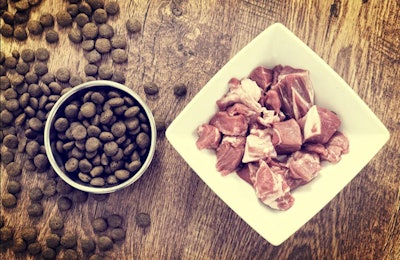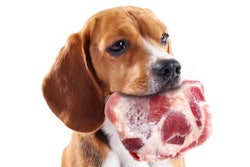
Pet food formulators should remember that cats are not small dogs, said David Thomas, PhD of Massey University in New Zealand, during his presentation at Petfood Forum 2018. The differences in feline and canine digestive systems, and the bacteria their guts harbor, were exemplified in the way that cats’ and dogs’ systems responded to nearly identical raw, high-protein diets, sometimes call biologically appropriate raw foods (BARF).
“These are high-meat content diets with little or no carbohydrates,” he said. “They’re increasingly popular worldwide, but there’s very little scientific data or nutritional health outcome data.”
Thomas and his colleagues have been focusing on these BARF diets over the last five or six years. One aspect of studying raw pet foods is that it takes out any effects of cooking or further processing these diets, he said.
How dogs and cats digest raw pet foods
In two separate studies, researchers fed similar raw pet food diet to dogs and cats. The studies were originally intended to look at differences related to kibble versus raw pet foods, but the scientists were able to use the data they collected to compare cats to dogs as well.
In both experiments, the raw pet food consisted of 73 percent beef muscle, 10 percent beef liver, 5 percent bone chip, 5 percent beef tripe, 3.5 percent beef heart, 3.5 percent beef kidney, 0.2 percent mineral premix specific to either dogs or cats. The only part of the formulation that differed was the mineral pre-mix.
“Apparent nutrient digestibility on these diets extremely high,” he said. “So how do cats and dogs respond to these high-meat diets?”
The scientists examined the animals’ feces after eating the BARF diets for three weeks and rated them on a five point score in which one is dry and five is liquid. Between 1.5 and 2.5 is considered ideal. The cats’ fecal score was 1.8 and the dogs’ was 3.5.
“The cats are the low end of that ideal range and the dog is slightly above it,” Thomas said.
Differences in intestinal microbes in dogs and cats fed raw diets
The organic acids in the dogs’ and cats’ feces differed in the ratio of acetate, propionate and butyrate.
The bacterial communities in the animals’ gut microbiomes influence these amino acid levels, he said. Just as the amino acids differed, so too did the species of microorganisms found in the feces and their prevalence.
In cats, the top genera of bacteria were Clostridium at 25 percent, Fusobacterium at 13 percent and then Prevotellaceae, Fusobacteriaceae and Eubacterium.
In dogs, Peptostreptococcus were the most prevalent genera at 28 percent, followed by Fusobacterium with 15 percent, Blautia at nine percent, then Collinsella and Clostridium.
“So, you get some similarities but a lot of differences in the two species response to basically a similar diet,” Thomas said.
About Petfood Forum 2019
Petfood R&D Showcase is scheduled for October 9-11, 2018 at Kansas State University in Manhattan, Kansas. SUPER Early Bird registration is now open.
Petfood Forum is the not-to-be-missed trade show event for pet food professionals from around the world to network, exchange ideas and do business with one another and with the industry's leading pet food manufacturers and suppliers. Petfood Forum 2019 will take place at the Kansas City Convention Center in Kansas City, Missouri, USA on April 29 – May 1, 2019.

















